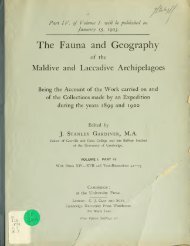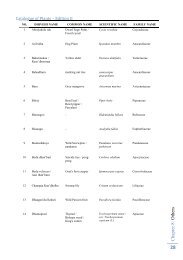656 R. C. PUNNETT.whilst the oesophagus at this level is very small. The genital pleurae are still large in thisregion but be<strong>com</strong>e much reduced shortly after it.Ptychodera viridis, n. sp. (PL XXX VII. figs. 2, 6, 7 ; PI. XXXIX. fig. 32; PI. XLII.figs. 17 and 19).Locality, etc. From Hulule, Maldive Is. Three specimens only, two being <strong>com</strong>plete,were dug from sand towards the cast of the island.External features. Coloured sketches from life of this worm were fortunately madeby Mr Forster Cooper. From the reproductions of these on Plate XXXVII. it will be seenthat green is the prevailing tint on the body of the animal, though the j)roboscis is paleyellow, and the collar pale yellow with a certain amount of orange. To the predominantbody tint the animal owes its specific name. From the sketches it appears that the proboscisis considerably longer than the collar, a proportion which still exists in the preserved creature.The length is not great. Of the two <strong>com</strong>plete specimens one measured 36 mm. and thesecond only 21 mm. in length after preservation (ratio of total length to collar length beingrespectively 18 : 1 and 14 : 1). Compared therefore with such forms as Pt. flava, var. laccadivensis,this sjjecies is a small, short, and somewhat stunted form. The genital pleuraeare well-developed. The external liver saccules are relatively feebly developed and are ofa uniform colour.Internal structure. The musculature of the proboscis is strong and <strong>com</strong>pact, theradial bundles into which the longitudinal muscles are gathered being closely connected byconnective tissue. The powerful development of the longitudinal muscles leads to the practicalobliteration of the proboscis cavity (PI. XXXIX. fig. 32). A well-marked dorsal musculardecussation occurs in the anterior part of the proboscis (PI. XXXIX. fig. 32, dmd) andfibres from it pass ventral to the central <strong>com</strong>plex. Dorso-ventral muscles anterior to thepericardium are not present. The ventral proboscis septum reaches forwards almost to thetip of the stomochord. The racemose organ is small and unlobulated. Both proboscis poresare present though only one is in functional <strong>com</strong>munication with the dorsal proboscis coelom.This may be either the right or the left one.Collar. The musculature and the connective tissue are here strongly developed andthe cavity of the collar is very much reduced. The dorsal septum occurs after the firstroot as usual and is generally <strong>com</strong>plete. Traces of the ventral septum may occur. Thelumen of the collar cord is almost entirely obliterated throughout and the cord in sectionhas as great a dorso-ventral diameter as a lateral one (PI. XLII. fig. 19). In one of thespecimens sectioned three roots were present of which the last was rudimentary.The cornua of the nuchal skeleton apparently vary much in length. In one specimenthey extended over about ^ of the collar, whilst in another they were rather more than aquarter as long as this structure.Trunk. The branchial region is short. Compared to the collar length as unity itmeasured in the three available specimens -85, I'OO, and 1-44, giving an average of 110.The branchial portion of the oesophagus is approximately of the same size as the ventralportion. The post-branchial groove is very ^hort and insignificant. The genital folds arelarge in the branchial region and also in the region of the post-branchial groove (PL XLII.fig. 17).
THE ENTEROPNEUSTA. 657Ptychodera asymmetrica, n. sp. (PL XXXVII. figs. 1 and 9; PI. XLVI. figs. 52, 56, 58).Locality, etc. From Hulule. According to Mr Stanley Gardiner, " Near the south isletis a pool with loose rocks well within the boulder zone. This form was found here inaccumulations of sand under stones. They are remarkable in life for the enormous quantityof mucus they secrete, so much indeed that it is almost impossible to obtain them cleanfor preservation." About 10 specimens were procured, mostly somewhat fragmentary.External features. A small form measuring on the average about 40 mm. in length(PL XXXVII. fig. 1). One larger specimen, a sketch of which was made by Mr ForsterCooper and is reproduced on PL XXXVII. fig. 9, measured after preservation 60 mm. inlength with a collar 3 mm. long. This specimen however was unusually large. Two pointsabout its external appearance merit attention. In the first place the liver saccules aresomewhat small and uniformly dark in colour. There is no sharp line of demarcation betweenan anterior set of very dark caeca and a posterior set of lighter ones as in Pt. Jiava, var.laccadivensis. In the second place careful examination shews that the left genital pleura isalways somewhat larger and more swollen than the right one. In all the eight specimensexamined by me the gonads shew asymmetry by being developed only on the left side.This was the case both in a very young specimen with quite immature gonads, and alsoin the large specimen above alluded to in which the gonads were full of ripe spermatozoa.In his account of Pt. flava Willey ('99, p. 240) mentions a case in which the gonadswere only developed in the right genital pleura, those in the left being apparently in astate of an-ested development. Evidently with the case of Asyminetron in his mind Willeywrites, " Such a differential behaviour of the two sides of the body is of interest as indicatinga tendency to unilaterality in the matter of the gonads." Spengel ('03, p. 305) criticisesthis remark of Willey's, regarding such a condition as produced by the presence of aparasitic copepod, Ive sp. In the two cases examined by Spengel where the gonads of oneside were undeveloped the parasite occurred in the genital pleura of that side, and thereseems little doubt that Spengel's explanation is here correct, and that the condition is apathological one. But there can be no doubt that this explanation will not hold for Pt.asymmetrica. The fact that in eight cases, in different stages of growth, gonads were alwaysabsent from the right pleura, coupled with tlie fact that no parasite was to be found,seems to shew beyond all question that unilaterality of the gonads is a feature which ischaracteristic of this species.Internal structure.Proboscis. The longitudinal muscles do not exhibit a markedly radial arrangement ofbundles. They are strongly developed and almost entirely fill the cavity of the proboscisso that there is no space, or only a very small one, between them and the central <strong>com</strong>plex.There are no dorso- ventral muscles in front of the pericardium. The ventral proboscis sepituradoes not reach to the tip of the stomochord and is often much shorter.The racemose organ is subject to considerable variation. It may be small and unlobulated,large and lobulated or not.There is usually a well-marked dorsal muscular decussation in the anterior part of theproboscis though no circular fibres pass from it ventrally.Collar. The cavity of the collar varies considerably. It is on the whole not largeand may be almost absent. The collar musculature is well-developed. The dorsal septum
- Page 7 and 8:
The Fauna and Geographyof theMaldiv
- Page 9 and 10:
The Fauna and Geographyof theMaldiv
- Page 11:
CONTENTS OF VOL. II.PAKT II.Reports
- Page 14 and 15:
..590 EDGAR A. SMITH.60at3aso-73a
- Page 16 and 17:
—592 EDGAR A. SMITH.3 SC3dSaitnhe
- Page 18 and 19:
,594 EDGAR A. SMITH.3-a ao5j,Moss3
- Page 20 and 21:
.596 EDGAR A. SMITH.3oa o"?!00 >iId
- Page 22 and 23:
598 EDGAR A. SMITH.3isaa'a
- Page 24 and 25:
600 EDGAR A. SMITH.Family ACTAEONID
- Page 26 and 27:
602 EDGAR A. SMITH.23. Conus lividu
- Page 28 and 29:
604 EDGAR A. SMITH,59. Harpa ventri
- Page 30 and 31:
606 EDGAR A. SMITH.Family BUCCINIDA
- Page 32 and 33:
608 EDGAE A. SMITH.below the suture
- Page 34 and 35: 610 EDGAB, A. SMITH.135. Sistrum bi
- Page 36 and 37: 612 EDGAR A. SMITH.173. Cypraea cla
- Page 38 and 39: 614 EDGAR A. SMITH.211. Triforis gr
- Page 40 and 41: 616 EDUAK. A. SMITH.which is a para
- Page 42 and 43: . 270.618 EDGAE A. SMITH.265. Clanc
- Page 44 and 45: 620 EDGAR A. SMITH.the shell being
- Page 46 and 47: 622 EDGAE A. SMITH.slender riblets
- Page 48 and 49: 624 EDGAR A. SMITH.330. Area (Barba
- Page 50 and 51: 626 EDGAR A. SMITH.FamilyPETRICOLID
- Page 52 and 53: 628 EDGAR A. SMITH.9. Chemnitz. Con
- Page 54 and 55: 630 EDGAR A. SMITH.Fig. 22. Natica
- Page 57: Plate XXXVI.mii>>-*"^-^ii,.•^16./
- Page 60 and 61: 632 B. C. PUNNETT.Willeyia hisulcat
- Page 62 and 63: 634 R. C. PUNNETT.No. of Specimen.(
- Page 64 and 65: 636 R. C. PUNNETT.Internal structub
- Page 66 and 67: 638 R. C. PUNNETT.The nuchal skelet
- Page 68 and 69: 640 R. C. PUNNETT.deeply sunk posit
- Page 70 and 71: 642 E. C. PUNNETT,but no giant cell
- Page 72 and 73: 644 R. C. PUNNETT.Ptychodera flava,
- Page 74 and 75: 646 R. C. PUNNETT.(PI. XLVI. fig. 4
- Page 76 and 77: 648 R. C. PUNXETT.The racemose orga
- Page 78 and 79: 650 E. C. PUXXETT.vialdivensis proc
- Page 80 and 81: 652 R. C. PUNNETT.Collar. The muscu
- Page 82 and 83: 654 R. C. PUNNETT.Table 5.Pt. flava
- Page 86 and 87: 658 R. C. PUNNETT.is always complet
- Page 88 and 89: 660 R. C. PUNNETT.Lastly there is a
- Page 90 and 91: 662 R. C. PUNNETT.apparently devoid
- Page 92 and 93: 664 R. C. PUNXETT.— '^^S*-!^^- Me
- Page 94 and 95: 666 R. C. PUNNETT.-Scr.— tu« HJ=
- Page 96 and 97: 668 E. C. PUNNETT.I ha\-e therefore
- Page 98 and 99: 670 K. C. PUNNETT.gonad spells incr
- Page 100 and 101: 672 R. C. PUNNETT.Table 11(continue
- Page 102 and 103: 674 R. C. PUNNETT.Table 13.Pt. flav
- Page 104 and 105: 676 R. C. PUNNETT.nlc.
- Page 106 and 107: 678 R. C. PUNNETT.Pig. 37. Ft. flav
- Page 108 and 109: 680 R. C. PUNNETT.PLATE XLV.Fig. 42
- Page 111: Fa-UTia and Geography Maldives and
- Page 115: 'Fauna and Geography Maldives aiid
- Page 119: Fauna and Geography, Maldives and L
- Page 123: Fauna and Geography, Maldives and L
- Page 127: Fauna and Geography, Maldives and L
- Page 130 and 131: (582 L. A. BORRADAILE.typical membe
- Page 132 and 133: 684 L. A. BORRADAILE.arrangement is
- Page 134 and 135:
:686 L. A. BORRADAILE.Subfamily Aca
- Page 136 and 137:
688 L- A. BORRADAILE.gaping. The sp
- Page 138 and 139:
:690 L. A. BORRADAILE.26. Lambrus (
- Page 140 and 141:
692 L. A. BORRADAILE.(12) The third
- Page 142 and 143:
694 L. A. BORRADAILE.macrurous grou
- Page 144 and 145:
:696 L. A. BORRADAILE.the whole, ho
- Page 146 and 147:
698 L. A. BORRADAILE.2. 6th alxloni
- Page 149:
Fauna and Geography, Maldives and L
- Page 156 and 157:
7. Lepidoptera ... .;...... 123Volu
- Page 158:
It was supposed that the whole work






